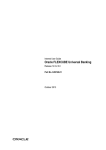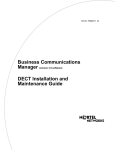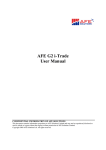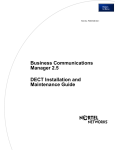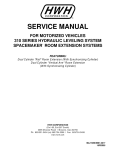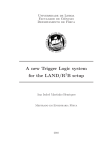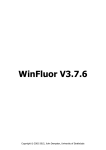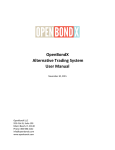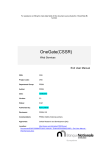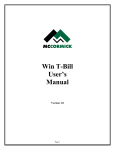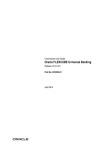Download Interest User Manual - Oracle Documentation
Transcript
Interest Oracle FLEXCUBE Universal Banking Release 11.3.1.0.0LA [January] [2012] Oracle Part Number E51536-01 Interest Table of Contents 1. ABOUT THIS MANUAL................................................................................................................................ 1-1 1.1 1.2 1.3 1.4 1.5 1.6 2. INTRODUCTION ........................................................................................................................................... 1-1 AUDIENCE .................................................................................................................................................. 1-1 ORGANIZATION .......................................................................................................................................... 1-1 CONVENTIONS USED IN THIS MANUAL ....................................................................................................... 1-1 GLOSSARY OF ICONS .................................................................................................................................. 1-1 RELATED DOCUMENTS ............................................................................................................................... 1-2 INTEREST ....................................................................................................................................................... 2-1 2.1 INTRODUCTION ........................................................................................................................................... 2-1 2.2 PROCESSING INTEREST ............................................................................................................................... 2-1 2.3 DEFINING FLOATING RATE CODES ............................................................................................................. 2-2 2.3.1 Indicating Tenor Code Details........................................................................................................... 2-3 2.4 DEFINING RATE SOURCES .......................................................................................................................... 2-5 2.5 DEFINING FLOATING RATES ....................................................................................................................... 2-8 2.5.1 Capturing Rate Code Details ............................................................................................................. 2-9 2.5.2 Capturing Currency Details .............................................................................................................. 2-9 2.5.3 Specifying Effective Date and Amount Slab Details ........................................................................ 2-10 2.5.4 Tenor and Interest Rate Details ....................................................................................................... 2-11 2.5.5 Rate Code Usage ............................................................................................................................. 2-11 2.6 MAINTAINING ICCF RULE AVAILABILITY................................................................................................ 2-13 2.7 MAINTAINING ICCF RULES ...................................................................................................................... 2-14 2.7.1 Features of the ICCF Rule Details screen ....................................................................................... 2-15 2.7.2 The Sequence in which ICCF Rules are resolved ............................................................................ 2-19 2.8 CREATING INTEREST CLASSES.................................................................................................................. 2-19 2.8.1 Specifying Interest Type Details ...................................................................................................... 2-20 2.9 LINKING AN INTEREST RULE TO A PRODUCT ............................................................................................ 2-22 2.9.1 Concept of Main Interest ................................................................................................................. 2-22 2.9.2 Methods of Interest Application ....................................................................................................... 2-22 2.9.3 Methods of Interest Collection ......................................................................................................... 2-23 2.9.4 Specifying Accrual Related Details ................................................................................................. 2-24 2.9.5 Mode of Repayment ......................................................................................................................... 2-24 2.9.6 Repayment type ................................................................................................................................ 2-24 2.10 SPECIFYING THE INTEREST DETAILS FOR THE PRODUCT ........................................................................... 2-26 2.10.1 Basis for Interest Application .......................................................................................................... 2-28 2.10.2 Interest Rate Details ........................................................................................................................ 2-33 2.10.3 Specifying Preferences for Floating Rate Pickup ............................................................................ 2-33 2.10.4 Product Limits ................................................................................................................................. 2-37 2.10.5 For Floating Rate Products ............................................................................................................. 2-37 2.10.6 Interest Details................................................................................................................................. 2-41 2.10.7 Floating Rate Details ....................................................................................................................... 2-47 2.10.8 Querying for overdue component details ......................................................................................... 2-48 2.10.9 Waiving an Interest Rule.................................................................................................................. 2-49 2.10.10 Amending Interest Components ................................................................................................... 2-49 2.10.11 Defining Interest Repayment Schedules ....................................................................................... 2-49 2.10.12 Defining Interest Payment Schedules for the Product ................................................................. 2-49 2.11 DEFINING INTEREST PAYMENT SCHEDULES FOR A CONTRACT ................................................................. 2-50 2.11.1 Revision Schedules and Repayment Schedules ................................................................................ 2-50 3. SCREEN GLOSSARY .................................................................................................................................... 3-1 3.1 FUNCTION ID LIST...................................................................................................................................... 3-1 1. About this Manual 1.1 Introduction This manual is designed to help you process interest on the contracts you enter in Oracle FLEXCUBE. You can further obtain information specific to a particular field by placing the cursor on the relevant field and striking <F1> on the keyboard. 1.2 Audience This manual is intended for the officers at your bank who set up rules for processing interest on the contracts entered in Oracle FLEXCUBE. 1.3 Organization This manual is organized as follows: Chapter 1 About this Manual gives information on the intended audience. It also lists the various chapters covered in this User Manual. Chapter 2 Interest explains how interest can be set up and processed. It details the procedure for defining interest rules, linking the rules to products, and applying them on a contract. 1.4 Conventions Used in this Manual Important information is preceded with the symbol. 1.5 Glossary of Icons This User Manual may refer to all or some of the following icons. Icons Function New Copy Save Delete Unlock Print Close 1-1 Icons Function Re-open Reverse Template Roll-over Hold Authorize Liquidate Exit Sign-off Help Add row Delete row Option List Confirm Enter Query Execute Query Refer the Procedures User Manual for further details about the icons. 1.6 Related Documents For further information on procedures discussed in the manual, refer to the Oracle FLEXCUBE manuals on: Common Procedures Products 1-2 2. Interest 2.1 Introduction Interest is an important component of contracts processed by your bank. It is expressed as a percentage of the principal amount. Typically, one party pays interest to another party for using the latter’s assets. Interest is typically expressed as an annual percentage rate (APR). You should define the attributes for interest components by way of defining interest rules. These interest rules should, in turn, be linked to a product, so that the attributes of the interest rule will be applied on all contracts involving the product. However, while capturing the details of a contract, you can modify some of the attributes defined for a rule. Further, for a contract, you can also indicate that the application of a specific Interest component should be waived. In this chapter, we shall discuss the processing of interest on contracts. This will include defining Interest Rules, linking them to a product, and applying them on a contract. Example You could link two Interest Rules to a product, one with 20% fixed interest and another with floating interest. These two will be processed as two different interest components. The expense and accrual accounts can be different for these components. The two interest components will be reported as different components in all reports and also in the customer correspondence relating to the contract. 2.2 Processing Interest You process interest in Oracle FLEXCUBE in the following manner: Before a product module becomes operational, you will need to maintain certain basic information on interest, which will later be linked to a product. To create this information, you will have to define floating rate codes, floating rates and interest rules. You create Interest Rules for interest with attributes suitable for the product where these rules will be applied. You will give each interest rule a specific Rule ID. When you define a rule, you restrict the use of the rule for the different branches of the bank, for different transaction currency, for different customer group and for a particular customer. When you define a product, you can choose the required interest rules that are applicable for contracts in the product and link these rules to the product. The product will inherit the Rule ID’s that are linked in this manner. Other attributes like rate of interest - fixed interest rate or floating interest rate etc are defined for individual products. When you enter a contract, the interest details defined for the product involved in the contract would be applied automatically on the contract. In other words, the interest rule is ‘defaulted’ from the product under which the contract is processed. However, if required, you can change some of the attributes, for a specific contract. 2-1 2.3 Defining Floating Rate Codes You can define rate codes using the ‘Rate Code Maintenance’ screen. You can invoke this screen by typing ‘CFDRTCD’ in the field at the top right corner of the Application tool bar and clicking the adjoining arrow button. You can enter the following details: Rate Code Enter a code to identify the rate you are defining. You can associate several currencies to the rate code and specify rates for each currency. While processing a contract, you need to indicate this code to make the rate applicable to the contract. The code cannot exceed 10 characters. Description Enter a brief description to identify the rate code being defined. Holiday Currency Specify the holiday currency for this rate code. You can choose the appropriate one from the adjoining option list that displays all valid currency codes maintained in the system. Floating rates prevalent in the market are recorded in the system as rate codes (E.g. LIBOR). The prevailing rates in the market are also recorded in the system. These rates are defined in a certain market (E.g. LIBOR rates comes from the London market). Hence the days on which that market is closed is determined by the holidays maintained for the related currency (GBP for LIBOR). This currency must be recorded as the ‘Holiday Currency’ for the Rate code. 2-2 Propagate Across Branches Check this option to indicate that the rate code should be available across all branches. 2.3.1 Indicating Tenor Code Details Here you need to indicate the following: Tenor Code Specify a unique code to identify the tenor for which this rate code should be applicable. Tenor Code Description Enter a brief description for the tenor code. You can add multiple tenor codes for the rate code by clicking add icon. Similarly, you can delete a tenor code by selecting the desired row and then clicking delete icon. In order to process MT340, MT360 and MT361 you need to maintain the following rate codes: AONIA BBR-AUBBSW BBR-BBSW SWAPRATE BA-CDOR BA CORRA TBILL ISDAFIX CLICP CIBOR DKKOIS ANNSR ANNUALSR EONIA EURIBOR TEC10-CNO HIBOR HONIX ISDA IDMA IDREFIX SBI SOR TELBOR01 TELBOR 2-3 BMK CMT INBMK MIBOR MIFOR MIOIS MITOR RFRCBANKS BBSF LIBOR MUTANCALL TIBOR TONA TSR CD3220 CD-KSDA TIIE-BANXICO NIBOR-NIBR BBR NZIONA WIBOR WIBOR ANNUAL STIBOR SIBOR SONAR SOR BRIBOR SOR THBFIX CMS COF11 FEDFUND FEDFUND ISDAFIX3 SANDPINDEX SIFMA TREASURYRATE TRSYRATE TRSYRATE BBR 2-4 BA BA TBILL TBILL LIBOR EURIBOR TAM TMM LIBOR HIBOR SOR LIBOR TSR BBR WIBOR SIBOR SOR BRIBOR SOR CMS COF11 ISDA LIBOR TIBOR 2.4 Defining Rate Sources You can maintain the source from where the interest rates have to be picked up by Oracle FLEXCUBE like Reuters, Bloomberg, using the ‘Rate Source Definition’ screen. You can invoke this screen by typing ‘CFDRTSRC’ in the field at the top right corner of the Application tool bar and clicking the adjoining arrow button. 2-5 Here you can capture the following details: Rate Source Specify a unique code to identify the rate source you wish to maintain. The code cannot exceed 10 characters. Description Enter a brief description for the rate source. In order to process MT340, MT 360 and MT361you need to maintain the following rate sources: SWPMKR AUBBSW BLBG 10:00-SWPMKR 11:00-BLBG 11:00-SWPMKR 3M-SWPMKR COMP-BLBG 365-BLBG BLBG SWAPRATE-11:00 SWAPRATE-4:00 RFRCBANKS BLOOMBERG-10:00 BLOOMBERG-15:00 FRASETT TONAR 2-6 17096 17097 BLBG REUTERS-10:00 REUTERS-15:00 CD3220 BLBG BID RFRCBANKS WIBO COMPOUND BLOOMBERG OIS-COMPOUND NBSK07 ICAPSP REUTERS H.15-BLBG H.15-OIS-CPD FIX3SR-3:00 SWAPRATE SWAPRATE-3:00 BBA-BLOOMBERG HIGHGRADE MCPLSWAPINDEX ICAPBKT SWPMKR100 SWPMKR99 ISDC ISDD TELERATE ISDD TELERATE ISDA TELERATE CDC CDC-COMPOUND ISDA ISDC TELERATE ISDA TELERATE-10:00 2-7 TELERATE-15:00 TELERATE RFRCBANKS WIBO TELERATE TELERATE BRBO TELERATE TELERATE TELERATE SWAP RATE 2.5 Defining Floating Rates The Interest Rate Type of a product can be one of the following: Fixed Floating Special A Floating Rate corresponds to the market rates for the day. These rates are maintained and updated daily (or whenever they change) in the Floating Rates Table. The rates can be applied on a contract with or without a spread. You can define Floating Interest Rates through the ‘LD MM Floating Rate Input’ screen. You can invoke this screen by typing ‘CFDFLTRT’ in the field at the top right corner of the Application tool bar and clicking the adjoining arrow button. 2-8 2.5.1 Capturing Rate Code Details A Rate Code identifies a set of rates defined for a combination of Currency, Amount Limit (optional), Tenor and Effective Date. Rate Code Enter a code to identify the Floating Rate you are defining. You can associate several currencies to the rate code and specify rates for each currency. While processing a contract, you need to indicate this code to make the rate applicable to the contract. 2.5.2 Capturing Currency Details Each Rate Code is associated with a currency. You can define rates for the same Rate Code in different currencies. Example You can have a Rate Code TERMDEP45 (with a description of Rates for a Term Deposit of 45 days). Thus, you can define a set of rates for contracts in U S Dollar and another set for contracts in Great British Pounds. When you link a contract in US Dollars to the Rate Code TERMDEP45, the rates defined for this currency will be applied. Similarly, if the contract is in Great Britain Pounds, the rates defined for that currency will be applied. 2-9 2.5.3 Specifying Effective Date and Amount Slab Details Amount Slab For a specific Rate Code and Currency combination, you can define an amount slab structure for application of interest rates. You should specify the upper limit of the slab to which a particular rate should be applied. A rate that has been defined for an Effective Date - Amount Slab combination will be applicable to an amount less than or equal to the specified amount. You can thus define interest rates for a slab structure. The following example illustrates how you can do this. Example Let us extend the example we discussed for Rates and Effective Dates to include amount limits. Amount (USD) Effective Date Interest Rate 10,000 01 January ‘97 12.5% 50,000 01 January ‘97 13.0% 999.9 million 01 January ‘97 14.0% If the rates have to be applied on 01 January ‘97, they will be picked up as follows: For a deposit with an amount less than or equal to USD 10, 000, the rate will be 12.5%. For a deposit with an amount greater than USD 10,000 and less than or equal to 50,000, the rate will be 13%. For a deposit with an amount greater than USD 50,000 and less than or equal to USD 999.9 millionth, the rate applied will be 14%. Notice that a huge amount (999.9 million) has been given as the last amount limit. This denotes that after 50,000 there is no upper limit in the slab. Further, if the component amount is greater than the highest slab, the appropriate rate for highest amount slab will be applied. Similarly, if the component amount is lesser than the lowest amount slab, the appropriate rate for lowest slab will be applied. Effective Date Each rate that you define for a Rate Code and Currency combination should have an Effective Date associated with it. This is the date on which the rate comes into effect. Once a rate comes into effect, it will be applicable till a rate with another Effective Date is given for the same Rate Code and Currency combination. The following example illustrates this point: Rate Code TERMDEP45 Currency US Dollar Effective Date Interest Rate 01 January ‘97 12.5% 14 January ‘97 12.0% 31 January ‘97 13.0% 2-10 These rates will be applicable as follows: Period Interest Rate 01 January to 13 January ‘97 12.5% 14 January to 30 January ‘97 12.0% 31 January to one day before the next date 13.0% The rates will be applied to a contract depending on whether it has been defined with Auto Rate Code Usage or Periodic Rate Code Usage. You can specify this in the Product ICCF Details screen. Borrow/Lend Rate Indication For every Amount Limit - Effective Date combination, you should define the rate to be applied as a borrow rate or a lend rate. You also have the option to specify the mid rate. 2.5.4 Tenor and Interest Rate Details The rates that will be applied for a given combination of Amount Slab – Effective Date – Lend/Borrow Indication can be tenor based. In the table, you can define tenors and indicate the rates applicable to each tenor. The rate will be applied to contracts based on the slab into which it falls and the reset tenor defined for the component. 2.5.5 Rate Code Usage If you specify Auto Rate Code usage, all the rate changes made during the liquidation or accrual period will be considered. If you specify periodic rate code usage, the rates will be periodically refreshed and the rates as of a specific frequency will be applied. This frequency is specified in the Contract Schedules screen while the Rate Code Usage is specified in the Product ICCF Details screen. The following example illustrates the concept: 2-11 Example You have a deposit that has a Start Date as 1 October 1997 and a Maturity Date as 30 November 1997. The interest payment frequency is to be monthly. The contract has been defined with a floating rate. The rates in the floating rate table change in the following manner: Effective Date Rate 1 October ‘97 12 12 October ‘97 11.5 25 October ‘97 11 15 November ‘97 12 30 November ‘97 12.5 If you want the floating rates to be applied automatically every time they change, you should specify Auto Rate Code usage in the Product ICCF screen. When you do this, if the first interest payment is to be done on 31 October, all the rate changes between 1 October and 31 October will be considered automatically. The rates will be applied for the number of days for which they remained unchanged in the rate table, as follows: From To Rate 1 October 11 October 12 12 October 24 October 11.5 25 October 31 October 11 If you want the floating rates to be refreshed periodically, you should first specify the rate code usage as periodic, through the Product ICCF Details screen. Next, you should define the rate revision schedules to specify when these rates should be applied on the deposit (that is, the frequency at which rates should be refreshed). To do this, through the Contract Schedules screen, mark the component as a revision schedule by checking the Rev box. Then, specify the component (for example, INTEREST). Specify the frequency at which the interest rate has to be refreshed, say every fortnight. Specify the Start Date as, say, 15 October. That is, for a deposit defined with periodic rate code application, the rates prevailing on the dates at the frequency you have specified will be used for accruals and liquidation. In the deposit we are discussing, with the frequency at which the rates should be refreshed defined as fortnightly and the Start Date as 15 October, the rate applied for the payment on 31 October will be as follows: From To Rate 1 October 15 October 11.5 16 October 31 October 11 Rev schedules are applicable only for contracts where the Rate Type is Floating and the Code Usage is Periodic. If the Code Usage is Automatic the system applies the effective rate whenever the underlying Rate gets updated. 2-12 2.6 Maintaining ICCF Rule Availability So far we have discussed the concept of a ‘main’ interest, the attributes of an interest component, and floating rate codes. Now, we go on to definition of an Interest Rule. An Interest Rule identifies the basic nature of an interest component. Each Interest Rule is defined by an alphanumeric code called the Rule ID. Attributes are defined for this Rule ID, which is then linked to a product. When a contract is processed, the interest attributes defined for the Rule ID linked to the product will be applied on the contract, some of which can be changed. An interest rule is created in the same way that any Interest, Commission, Charge and Fee (ICCF) rule is created, as follows: The rule is created at the head office branch, by giving it a unique identification and description, in the ICCF Rule Branch Availability screen. In this screen, the rule is made available for use in the required branches by maintaining an allowed / disallowed list of branches. At the required branch, in the ICCF Rule Details screen, the attributes for the rule are defined. Maintaining the attributes in this screen is subject to whether maintenance of ICCF rules is allowed for the branch, and also whether the rule for which attributes are being defined, is allowed for the branch. To recall, at the head office of your branch, you can create appropriate ICCF rules and make the rules available to the required branches. In the ‘ICCF Rule Availability Maintenance’ screen, you can maintain ICCF rules, which you can make available to desired branches. You can invoke this screen by typing ‘CFDICCFR’ in the field at the top right corner of the Application tool bar and clicking the adjoining arrow button. You can do this by maintaining a list of branches for which the use of the rule is allowed, or disallowed. In this screen, you must specify the following information: 2-13 Rule Identification and Description You must specify a unique identification for the ICCF rule you are creating. If you are creating a charge rule, specify a unique identification for the interest rule. This is the code that will be used to identify the rule, in all subsequent references to it. You must also specify a unique description for the rule. After the rule has been created in the ICCF Rule Branch Availability screen, the attributes for the rule must be defined in the ICCF Rule Details screen. Branch Restrictions You can maintain a list of allowed branches (that is, the rule will be available for use in the allowed list of branches) or disallowed branches (the rule will not be available for use in the branches in the disallowed list). To recall, the attributes for the rule are defined, in the ICCF Rule Details screen. Maintaining the attributes in this screen, for a branch, is subject to whether maintenance of ICCF rules is allowed for the branch, and also whether the rule for which attributes are being defined, is allowed for the branch. For details about the Common Branch Restrictions, refer the Security Management System user manual. Example You have created the following Common Branch Restrictions: Home Branch Restriction Type Allowed Branches 000 ICCFRULE 000, 001, 002, 005 001 ICCFRULE 001, 006 The administrator of branch 000 can create, modify and delete ICCF rules in the branches 000, 001, 002 and 005, but not for 006. 2.7 Maintaining ICCF Rules To recall, after an interest rule has been created in the ‘ICCF Rule Availability Maintenance’ screen, the attributes for the rule must be defined in the ‘ICCF Rule Maintenance’ screen. You can invoke this screen by typing ‘CFDRUMNT’ in the field at the top right corner of the Application tool bar and clicking the adjoining arrow button. 2-14 2.7.1 Features of the ICCF Rule Details screen As you are defining an interest type of component, (that is, a tenor based component), you need to specify only the following details through the ICCF Rule Details screen: Rule Type Rule ID Rule Description Rule Currency, Customer and Branch combinations The values defaulted by the system in the fields under the Rate Details and Tenor Details tabs should not be altered. These will not have any effect on the Interest Rule which is being created. All the other details of the component must be specified through the Interest Class Screen. The Interest Class screen allows you to specify details regarding different attributes such as the following: Fixed, Floating or Special interest rates Penalties calculated based on the main interest Accrual of interest Rule Type The Rule Type identifies the type of ICCF component you are defining. In this case it is Interest. The attributes applicable for a component depends on its Rule Type. 2-15 For example, you can define any component that is tenor based an annual fee, for example - as a component of Rule Type Interest. If INTEREST1 is your main interest, your annual fee can be defined as INTEREST2, as it is tenor based. Only on an Interest type of component can you have floating rates. Rule ID Each Interest Rule is defined by an alphanumeric code called the Rule ID. Attributes are defined for this Rule ID, which is then linked to a product. When a contract is processed, the interest attributes defined for the Rule ID linked to the product will be applied on the contract, some of which can be changed. To recall, the Rule ID for an interest rule is specified in the ICCF Rule Branch Availability maintenance. Accordingly, in the Rule ID field in this screen, you must select the ID of the interest rule that you wish to build by maintaining the attributes. The option list in the Rule ID field is populated based on the following conditions: Only those Rule IDs that are available for users at the current branch according to the ICCF Rule Branch Availability maintenance are displayed The maintenance of ICCF rules must be allowed for users at the current branch, according to the restrictions maintained in the Common Branch Restrictions maintenance for the restriction type ICCFRULE. If no Common Branch Restrictions have been maintained, and the restriction type ICCFRULE has not been maintained in the SMS Branch Restriction Type maintenance, the option list in the Rule ID field only displays those rules that are available for users in the current branch, according to the ICCF Rule Branch Availability maintenance. You must select the Rule ID to have all the bank branches listed in the Branch field list of options. 2.7.1.1 Interest Rule Application Factors The conditions for the application of an interest rule can be defined in the ICCF Rule Details screen. The rule can be applied to any contract, irrespective of the currency of the contract, the customer and the branch involved. This is referred to as a general interest rule. You must define a general interest rule that would be applicable for any contracts in any currencies, involving any customers, customer groups or branches, before you define rules applicable to specific customers and contracts in specific currencies and in specific branches. The general rule can only be maintained at the head office branch. Thus, the most general application of the condition can be that it is applicable to contracts in any currency and involving any customer. After defining the general interest rule, you can then proceed to define rules that can be applied to contracts involving the following specific combinations: A specific branch, customer category, customer and currency A specific branch, customer category, customer and all currencies A specific branch, customer category, currency and all customers A specific branch, currency and all customer categories and customers A specific branch, customer categories and all currencies and customers A specific branch and all customer categories, customers and currencies 2-16 A specific customer category, customer, currency, and all branches A specific customer category, customer and all currencies and branches A specific customer category, currency and all customers and branches A specific currency and all customer categories, customers and branches A specific customer category and all customers, currencies and branches All branches, customer categories, customers and currencies As mentioned earlier, the rules applicable for combinations involving all branches (the ALL option in the Branch Code field) can be maintained only from the head office branch. Once an Interest Rule has been defined, you must create an Interest Class for the Interest Rule. Creating an interest class for every Interest Rule is mandatory. The details specified for Interest Class is then defaulted to the product you define. The definition of a product should ideally be preceded by the definition of all Interest Rules applicable to the product. If not, the product definition has to be put on hold, the Interest Rules defined, and then the product linked to the Interest Rules. Transaction Currency If you wish to define the attributes for all currencies, you can select the ALL option in the Currency Code field to indicate this. If you are maintaining the attributes for the selected ICCF rule in specific currency other than the ALL, select the Transaction Currency on which the rule mapping maintenance is to be made applicable. Customer Group Select the customer group on which the rule mapping maintenance is to be made applicable. You can create a generalized interest rule mapping record by selecting the ALL option in the Customer Group field. This specification defaults to the Customer and Customer Account fields. You are forbidden to change the specification. Customer Specify the customer id (CIF) of the customer for whom you are maintaining the rule mapping.. Branch Code If you are maintaining the attributes for the selected ICCF rule from the head office branch, you can select the branch for which the attributes are being defined. If you wish to define the attributes for all branches, you can select the ALL option in the Branch Code field to indicate this. If you are maintaining the attributes for the selected ICCF rule from a branch other than the head office, you can only select those branches that are found in the allowed list of branches for: the ICCF rule definition Restriction Type (ICCFRULE), in the Common Branch Restrictions maintenance for the current branch the selected rule being built, according to the ICCF Rule Availability maintenance In other words, the option list in the Branch Code field would display only those branches that are allowed both for the rule and the current branch. The following example illustrates how the option lists in the Rule ID and Branch Code fields are populated: 2-17 Example You have created the following Common Branch Restrictions for the restriction type ICCFRULE: Home Branch Allowed Branches 000 000, 001, 002, 005 001 001, 006 002 002, 005, 006 005 002, 005, 006 You have maintained the following rules in the ICCF Rule Branch Availability Maintenance: RULE ID Allowed Branches INTRULE1 000, 001, 002, 005, 006 INTRULE2 001, 005, 006 INTRULE3 002, 005,006 In the ICCF Rule Details screen, the following options would result if the maintenance were as mentioned above: Branch Rule ID field option list Branch Code option list 000 INTRULE1 000, 001, 002, 005 001 INTRULE1, INTRULE2 001, 006 002 INTRULE1, INTRULE3 002, 005, 006 005 INTRULE1, INTRULE2, INTRULE3 002, 005, 006 (for INTRULE1), 005, 006 (for INTRULE2) or 002, 005, 006 (for INTRULE3) If no Common Branch Restrictions were maintained and the restriction type ICCFRULE were not maintained in the SMS Branch Restriction Type maintenance, the options in the ICCF Rule Details screen would be as follows: Branch Rule ID field option list Branch Code option list 000 INTRULE1 000, 001, 002, 005, 006 001 INTRULE1, INTRULE2 000, 001, 002, 005, 006 (for INTRULE1) or 001, 005, 006 (for INTRULE2) 002 INTRULE1, INTRULE3 000, 001, 002, 005, 006 (for INTRULE1) or 002, 005, 006 (for INTRULE3) 005 INTRULE1, INTRULE2, INTRULE3 000, 001, 002, 005, 006 (for INTRULE1), 001, 005, 006 (for INTRULE2) or 002, 005, 006 (for INTRULE3) 2-18 2.7.2 The Sequence in which ICCF Rules are resolved ICCF Rules that you maintain are resolved in the following sequence: Rule Branch Customer Category Customer Currency Specific Specific Specific Specific Specific Specific Specific Specific Specific ALL Specific Specific Specific ALL Specific Specific Specific ALL ALL Specific Specific Specific Specific ALL ALL Specific Specific ALL ALL ALL Specific ALL Specific Specific Specific Specific ALL Specific Specific ALL Specific ALL Specific ALL Specific Specific ALL ALL ALL Specific Specific ALL Specific ALL ALL Specific ALL ALL ALL ALL 2.8 Creating Interest Classes A class is a specific type of component that can be built with certain attributes. For instance, for a Security, you can build an interest class with the attributes of a specific type of coupon, the quarterly coupon paid on the current face value. This chapter explains how interest classes are built and how attributes are defined. The building of interest classes is applicable to Securities and Derivatives products and contracts. You can use the information in this chapter to process interest components for Securities and Derivatives contracts. When building an interest class, certain attributes, such as the following can be defined: The module in which you would use the class The interest type The association event The basis amount on which the coupon is paid The rate type The default rate code (for floating interest) The default tenor 2-19 You can define the attributes of an interest class, in the ‘Interest Class Maintenance’ screen, invoked from the Application Browser. You can invoke the ‘Interest Class Maintenance’ screen by typing ‘CFDINTCL’ in the field at the top right corner of the Application tool bar and clicking the adjoining arrow button. Before defining the attributes of an interest class, you should assign the class a unique identifier, called the Class Code and briefly describe the class. A description would help you easily identify a class. Module An interest class is built for use in a specific module. This is because; an interest component would be applied on different basis amounts, in different modules. Example In the Derivatives module, you would apply interest on the principal amount. In the Securities module, you can have coupons on the basis of the current face value. The basis on which the component is calculated is different in these two cases. Please note that the Basis Amount Tags available would depend on the module for which you build the class. 2.8.1 Specifying Interest Type Details While building an Interest Class, you can define two kinds of interest: Primary Interest Coupon Example While building an Interest Class for the Securities module, you can only define Coupon details. 2-20 When building interest class for the Derivatives module, you can only define primary interest details. Subsequently you are also required to specify whether the interest type is applicable for the in leg or for the out leg of contracts linked to this class Events and the Basis Amount The term Event can be explained with reference to a deal. A deal goes through different stages in its life cycle, such as: Deal Booking Money Settlement of Deal Reversal of Deal Cancellation of Deal Each stage is referred to as an Event in Oracle FLEXCUBE. The event at which you would like to associate the interest component, being defined, to a contract is referred to as the Association Event. The basis on which an interest is calculated is referred to as the Basis Amount. For instance, a coupon can be on the basis of the current face value of a security. When building an interest class, you have to specify the tag associated with the Basis Amount. The attributes defined for an interest class, will default to all products with which you associate the class. When maintaining interest details for a product, you can change these default attributes. Contracts maintained under a product will acquire the attributes defined for the securities product. Accrual Required You can choose to accrue the interests due on a contract. To accrue the interest payable on a contract, choose the ‘Accrual Required’ option. The accrual details that you define for an interest class will default to all products with which you associate the class. When maintaining interest accrual details for a product, you can change these default details. Contracts maintained under a product will acquire the accrual details defined for the product. However, you can define unique accrual details for a contract. Rate Type The interests paid on contracts can be at a Fixed Rate, or on the basis of a Floating Rate. If you indicate that interests should be calculated on the basis of a Floating Rate, you must specify the ‘Periodic’ Floating Rate Type. For all contracts maintained under products, associated with a class, the interest will be by default calculated using the specified Rate type. Default Rate Code Interest payable on contracts would be calculated at specific rates. When building an interest component, you have to specify the rate at which the interest should be computed. When associating a rate code (that you have maintained in the Rate Codes Maintenance screen) with the interest component that you are building, the rates corresponding to the code will be used to compute interest. 2-21 The details defined for an interest class will default to all products with which the class is associated. When maintaining interest details for a product, you can change this default information. Contracts maintained under a product will acquire the interest details defined for the contract product. However, you can define unique interest details specific to a contract. When maintaining a contract, you can choose to waive the rate code altogether or amend the properties of the code to suit the security. If you allow amendment of a rate code, you can specify if you would like to allow rate code amendment after the association event. You can also allow the amendment of the rate value (corresponding to a rate code). Default Tenor Each rate code is associated with a tenor. For instance you have a Rate Code ‘LIBOR’. You can link any number of tenor codes to the same rate code. Tenor Code Description 1W One week rate 2W Two week rate 2M Two months rate 6M Six months rate 1Y One year rate When building an interest component, you can specify a Tenor Code that you would like to associate, with the Floating Interest Rate Code. Interests for contracts (maintained under a product with which you associate the class) will be calculated using the rate corresponding to the Rate Code and the Tenor Code. 2.9 Linking an Interest Rule to a Product The following section describe the concepts and the facilities involved in linking an Interest Rule to a Product. 2.9.1 Concept of Main Interest If a product, and hence a contract involving the product, has more than one type of interest applicable, you should designate one of them as the Main Interest. You can do this while defining the interest details for the product. For capitalization and amortization (repayment in Equated Installments) purposes, the main interest component will be considered. You can choose to set up as many interest rules as you wish to apply on the product and subsequently, on the contract. 2.9.2 Methods of Interest Application Interest can be applied in different ways, as follows: 2-22 Fixed An interest rate is fixed at the time of initiating the contract. The repayment amounts will be computed based on this rate of interest and the repayment schedule. However, the interest rate applicable on a contract can be changed after the contract has been initiated. You should indicate that this change should come into effect as of a date called the Value Date. The interest amount will be computed based on the new rate effective from the Value Date. Floating The market rates (with a spread or without it) are applied on the contract. This application can be done in two ways: Every time the market rate changes Only at periodic intervals Floating rates prevalent in the market are captured in the system as rate codes (Ex LIBOR). The prevailing rates in the market are also captured in the system. These rates are defined in a certain market (For Ex LIBOR rates comes from London market).These market rates are stored in the Floating Rates table. The rates are defined for a combination of Rate Codes, Currency and Value Date. If the rates have to be applied periodically, the frequency of application should be defined for each contract. 2.9.3 Methods of Interest Collection Bearing The Interest is liquidated on schedule payment date(s). Example You have Ms Yvonne Cousteau’s deposit of USD 10,000 under the scheme ‘Short Term Deposits for Individuals’, at 10% interest per annum, for a year. Under the bearing type of interest payment method, the deposit of USD 10,000 is collected from Ms Cousteau and the interest on it is paid out over the one year, which is the tenor of the deposit. Discounted In this interest payment method, the interest is deducted at the time of initiating the contract. Example Take the case of Ms Yvonne Cousteau’s deposit of USD 10,000 under the scheme ‘Short Term Deposits from Individuals’, at 10% interest per annum, for a year. Under the discounted type of interest payment, the total interest calculated for the tenor of the deposit, USD 1,000, is deducted from the nominal (USD 10,000) and only USD 9,000 is accepted. This forms the principal of the deposit. At maturity, Ms Yvonne Cousteau gets back USD 10,000. True Discounted In this interest payment method, the interest is calculated on the principal in a manner that is slightly different from the Discounted method. The interest rate is applied on the Principal instead of the Nominal, as it is done in the Discounted method. Example Again, take the case of Ms Yvonne Cousteau’s deposit of USD 10,000 under the scheme ‘Short Term Deposits from Individuals’, at 10% interest per annum, for a year. 2-23 Under the True Discounted type of interest payment method, the interest calculated on the principal, USD 9000, (arrived at after deducting 10% interest on the nominal – USD 10,000) is deducted from the nominal and USD 9,100 is accepted. This forms the actual principal of the deposit. At maturity, Ms Yvonne Cousteau gets back USD 10,000. You can specify this preference for individual products under different modules. 2.9.4 Specifying Accrual Related Details You have to specify two aspects about interest accruals: Whether accruals have to be carried out If yes, their frequency For a product you should specify, through the Product ICCF Details screen, whether accruals have to be carried out. If yes, the frequency of accruals (whether daily, monthly, quarterly, halfyearly or annual) should be specified for the product through the Product Preferences screen. This will apply to the accruable components of all contracts involving the product. Accruals will be carried out at the specified frequency by the Automatic Contract Update function during the End of Day processes. In addition, interest will be accrued whenever a backdated event (like a rate change with a Value Date, a payment, etc.) is triggered as of a date beyond the date on which the last accruals were carried out. 2.9.5 Mode of Repayment The repayment schedules for interest should be defined for each contract. Depending on the mode of payment applicable, the interest will be liquidated, either automatically or manually, according to this schedule. The mode of repayment for interest can either be automatic or manual. Specify this preference in ‘Code Usage’ field. When the repayment is automatic, interest will be liquidated on the schedule repayment dates automatically by the Automatic Contract Update program. On the other hand, if the repayment is manual, instructions for liquidation should be entered in the system when the repayment is made. The mode of repayment has to be specified for a product, but you can change it for a contract. For BC contracts, all outstanding accruals during full repayment are passed unconditionally during the YACR (YTM based discount accrual) event. To recall, this event is meant to indicate the periodic discount accruals for a BC contract. For more information on discount accruals, you can refer to the chapter titled ‘Defining Discount Accrual Fee Classes’ in the BC (Bills and Collections) User Manual. 2.9.6 Repayment type You must specify the type of repayment schedule as amortized, capitalized or normal, while defining a product. The type you have specified will be applicable to all the contracts involving the product and will be displayed in the Contract On-line Preferences screen. You can capitalize the interest payment on a contract by: Specifying the type of schedule (through the Product Preferences screen) as Capitalized. The contract inherits this from the product Specifying the frequency for the capitalization through the Product Default Schedules screen 2-24 If you have specified capitalization and defined schedules for the components of the contract, the unpaid interest will be capitalized for the next schedule. That is, the unpaid interest will be added to the unpaid principal and this will become the principal, for the next schedule. Example You have specified that the interest should be capitalized for Ms Yvonne Cousteau’s deposit of USD 20,000, and indicated the frequency as quarterly. The first schedule date is 30 June 1998. On this date, the outstanding principal on Ms Yvonne Cousteau’s deposit is USD 20,000, and the outstanding interest at 20% is USD 986 for the first three months. Since it is to be capitalized, this is added to the principal and USD 20,986 becomes the principal on which the interest is calculated during the next quarter. Capitalization is done only for the ‘Main’ interest and only if it is a fixed interest of the bearing type. You can have equated installments for the contract on the schedule dates by specifying Amortization as the schedule type and specifying the frequency. These repayment schedules will be drawn up taking into consideration the Principal and the Main Interest (that component which you have defined for display in the Contract Details screen). If you specify amortized schedules, the system will automatically do the amortization, according to the frequency defined. The schedule type can be amortized only if the amount has a fixed type of interest and bearing interest payment method. If you specify the schedule type as Normal, you can tailor schedules for the various components to suit your needs. A schedule date: Should be later than or the same as the Value Date You can have only one schedule, for a component for a date It cannot be beyond the Maturity Date 2-25 2.10 Specifying the Interest Details for the Product After you have defined an Interest Rule by allotting it a Rule ID and specifying the interest application factors, you can link it to a product. When a contract involving the product is processed, the interest attributes defined for the product will be applied on the contract. Some of these attributes can be changed during contract processing. Click ‘Interest’ button in the ‘Product Definition’ screen to invoke the ‘Interest Details’ screen. You can link more than one rule to a product. In the Product ICCF Details screen, in the Rule ID field, pick the rule you wish to link to the product. For an interest type of rule, all the interestrelated details have to be specified in the Product ICCF Details screen. Example For a deposit, you can link a rule for the main interest and another interest type of rule for a commission you want to charge on the deposit. Besides this, you can have a rule for a charge. Thus, the product will have three rules linked to it. For the deposit, you can retain all these, or waive one or more, as per your requirement. 2-26 The interest details defined for a product will be automatically applied on a contract involving the product. However, you can change certain attributes of interest for a specific contract. A note on the Accounting Role build-up The system automatically builds a list of accounting roles depending on the Interest components that you define. For instance, if you have defined an interest component called CR01_INT, the following accounting roles will be generated: CR01_INT_EXP CR01_INT_PAY CR01_INT_REC CR01_INT_RIA CR01_INT_PIA CR01_INT_AQP CR01_INT_AQR CR01_INT_ADJ The system dynamically adds a list of suffixes to the main interest component. Each of these suffixes stand for: Suffix Represents AQR Acquired interest receivable AQP Acquired interest payable REC Receivable EXP Expense INC Income PAY Payable RIA Received in Advance PIA Paid in Advance ADJ Adjustment A similar list of accounting roles will be built up for each component that you associate with the product. Since you need to identify Accounting Roles (GL/SL Types) and map them to Account Heads (Actual GL/SLs) to post accounting entries for specific events, you will have to choose the appropriate accounting roles for each component and map them to corresponding Account Heads. Event An interest event indicates when the interest component whose attributes are being defined has to be applied. 2-27 2.10.1 Basis for Interest Application The basis of the interest component being defined specifies the following two attributes: Amount Type If the interest rate type is Fixed or Floating, the Amount Type specifies the basis amount on which the interest rate has to be applied. For example, for the FT module, it could be the Transfer amount, for the LC module, it could be the LC Contract Amount and so on. Grace Period and Level Number You can apply interest at various levels: Main interest on principal – Level 0 (Category: Expected) Interest on overdue interest – Level 1 (Category: Overdue) Interest on Level 1 interest – Level 2 (Category: Overdue) … and so on. For each interest component, starting from Level 1 and belonging to ‘Overdue’ category, you can also specify the number of grace days, beyond the main interest due date, after which that interest component becomes applicable. For each such component, the default value for the number of grace days is: Number of grace days for the previous level + 30 days You can change this value, provided that the number of grace days for a component (level) does not exceed the number of grace days for any successive level. At any point, an amendment of the number of grace days for any or more interest components at the Product ICCF level will only affect new contracts. For interest components of Level 0 and ‘Expected’ category, the default value for grace days is 0 – this cannot be changed. Settlement Currency The Settlement Currency is the currency in which the interest amount will be calculated. The interest amount applicable for a contract will be calculated in this currency. The appropriate conversion rate (defined for the product as the applicable Rate Type) will be applied to carry out a conversion if the repayment account is in a different currency. Category If the interest rate type is Fixed or Floating, the Amount Basis Category specifies the type of balance that has to be considered for interest application. It could be any one of the following: Expected Overdue Normal Outstanding If the Basis Amount Category is Expected, the balance on which interest has to be applied will be the Expected balance (the balance assuming that all the scheduled repayments defined for the contract are made on time). An example of this category is the application of interest on the Bill amount. If the Basis Amount Category is Overdue, the balance on which interest has to be applied will be the amount that is overdue, based on the repayment method defined for the contract. An example of this category is the application of penalty interest on the bill amount or interest, when a repayment has not been made, as per the date specified for the contract. 2-28 Example Let us consider a deposit of USD 1000, the contract spanning 10 months. The number of schedules by which the principal has to be paid back is 10 installments, each schedule amounting to USD 100. Contract start date 1 March 1997 Contract end date 31 December 1997 Schedule dates End of every month Schedule frequency Monthly Schedule amount USD 100 plus interest applicable Date Principal Schedule Amt Expected Bal 31 March 1997 100 900 30 April 1997 100 800 31 May 1997 100 700 30 June 1997 100 600 31 July 1997 100 500 31 Aug 1997 100 400 30 Sept 1997 100 300 31 Oct 1997 100 200 30 Nov 1997 100 100 31 Dec 1997 100 None When the interest has to be applied on the outstanding balance, the category 'Outstanding' has to be chosen. The category 'Normal' is used for commission. E.g. for of an LC, as the balance on which a commission is applied will always be the outstanding balance and the basis amount category for an LC is 'Normal'. When you specify the Basis Amount Category as Expected, the interest will be applied on the Expected Balance. The overdue category is not applicable to money market deals. 2-29 Prepayment Method The prepayment method identifies the computation of the prepayment penalty for the contract. The prepayment penalty for deposits is computed as depicted in the equation given below: Here, 1. Prepayment Penalty indicates the penalty amount calculated. 2. Deposit Amount Withdrawn indicates the deposit amount withdrawn prematurely. 3. Prepayment Penalty Rate indicates the Rate input in Payment screen for calculation of penalty. 4. Interest Basis indicates the Interest basis for the component for which penalty is being computed. 5. Number of Days indicates the day count for which penalty needs to be calculated. This is calculated based on the ‘Prepayment Method’ field defined in the Product Definition. In addition to using the formula to calculate the Prepayment Penalty, the actual prepayment penalty amount being charged to the customer is also dependent on the Prepayment Method. The options available are: Oracle FLEXCUBE This option is used where pre-payment has to be applied on the deposit contract for contract elapsed days. Custom If the Prepayment Method is Custom, then the prepayment penalty in this case will be the minimum of prepayment penalty and Gross interest on the premature withdrawal amount. The system computes the interest amount to be liquidated due to prepayment of principal. You will not be allowed to specify the interest amount during the Payment input in such a case. Here, the system does not include the Acquired interest for processing. Also, if you have chosen the prepayment method as Custom, you cannot prepay or manually liquidate either the interest or the principal component. This option is used where pre-payment has to be applied on the deposit contract for contract remaining days. Accruals For a product, you should specify through the product ICCF Details screen whether accruals have to be carried out for the accruable components. If yes, the frequency of accruals, which could be daily, monthly, quarterly, half-yearly or annually, should be specified for each product (through the Product Preferences screen). The accruals are carried out at the specified frequency by the Automatic Contract Update function. In addition, accruals are done whenever an event (like a rate change with a Value Date, a payment, etc.) is triggered as of a date beyond the date on which the last accruals were carried out. 2-30 Allow Amendment A change to a contract (after it has been authorized) that involves a change in its financial details constitutes an Amendment on the contract. You can indicate whether such an Amendment, called a Value Dated Change, should be allowed for the interest component being defined. You can amend the following through this function: Interest rate Rate code Spread Interest amount Main Component You can define any number of interest type of components (tenor based components) for a product. If you have defined more than one interest type of component, you can specify the main interest component as ‘Main Component’. This will be the interest component that will be used for capitalization or amortization purposes if the repayment schedules are defined thus. The details of this Main Component will be shown in the Contract Details screen and you can change them there without having to invoke the Contract ICCF Details screen. Components other than the main component have to be processed through the Contract ICCF Details screen. Bulk Amount When a contract gets rolled over, you may wish to split it into 2 contracts - one for the interest amount (I) and the other for the principal amount (P). If you want the the floating rate pickup for both the new contracts (tenor/amount) to be based on P+I of the original contract, check the 'Bulk Amount' check box. Example If the principal amount is Rs.1000 and Interest accrued is Rs.100. Upon rollover, your bank may require two contracts, one for Rs.1000 (Principal contract) and the other for Rs.100(interest contract). Lets say the slab rate followed by your bank is: 0 – 1000 - 3% 1001 – 2000 - 4% In the normal course, system would apply 3% interest rate on both the contracts of Rs.1000 and Rs.100 (since both fall within 0 -1000 slab). But if the ‘Bulk Amount’ option is chosen, then 4% will be applied on both the contracts (as if a single contract of Rs.1100 is rolled over where system would have applied 4pct). Stop Application The attributes defined for a product will be automatically applied to all contracts involving the product. If, for some reason, you want to stop applying the Interest Rule defined for the product on contracts that are to be initiated in the future (involving the product), you could do so through the Product ‘ICCF Details’ screen. In effect, stopping the application of a component for a product would be equivalent to deleting the component from the product. By specifying that the application of the component should be stopped, you have the advantage of using the definition made for the component again, by making it applicable. 2-31 Propagation Required If the interest amount collected from the borrower should be passed on to participants of the contract, check the 'Propagation Required' check box. Consider as Discount While defining an interest for the bills module, you can indicate whether the interest component is to be considered for discount accrual on a constant yield basis or whether accrual of interest is required. If you select the Consider as Discount option the interest received against the component is used in the computation of the constant yield and subsequently amortized over the tenor of the associated contract. This accrual is processed through the Discount Accrual module. Refer the Discount Accrual chapter of Bills User Manuals. The ‘Consider as Discount’ option is allowed only for the following events (for bills): BADV (acceptance to advance event) BPUR (collection to purchase event) BDIS (acceptance to discount event) INIT (initiation event) To recall, you link an interest component to an event through the ‘Event’ option list. If you select the ‘Accruals’ option, the interest is accrued depending on the accrual preferences defined for the product. If neither option is selected, the interest is not accrued, but is recognized as income on interest liquidation. Checking the ‘Consider as Discount’ also indicates whether the interest component is to be considered for IRR computations of bills. If the payment type is ‘Discounted’ then you can select either ‘Consider as Discount’ and ‘Accruals’ option OR both together. If the options ‘Accruals’ and ‘Consider as Discount’ are selected then discounted interest is considered for IRR calculation. If the option ‘Accruals’ is not checked and ‘Consider as Discount’ is checked then the discounted interest is considered to be a part of total discount to be accrued. The above validations apply for BC (Bills and Collections) contracts also. The ‘Consider as Discount’ option is not available if the amount category is Penalty. The options ‘Accruals’ and ‘Consider as Discount’ are not mutually exclusive. If you select the ‘Accruals’ option, then it is not necessary for the ‘Consider as Discount’ option to be checked. However, for BC contracts, if you select the ‘Accruals’ option, you can either select against the ‘Consider as Discount’ option or otherwise. For Bearing contracts, if the option ‘Consider as Discount’ is checked then the option ‘Accruals’ also has to be checked. If the option ‘Accruals’ is not checked, the option ‘Consider as Discount’ is disabled. The above validations apply for BC (Bills and Collections) contracts also. 2-32 Link Contract as Ratecode You can use this field to indicate whether a fixed rate contract may be linked to the floating rate component, instead of a rate code. Check this box to indicate that a fixed rate contract may be linked. 2.10.2 Interest Rate Details Rate Type The Rate Type indicates whether the interest is a Fixed Rate, a Floating Rate or a Special amount. When creating a product, you should specify the Rate Type through the ‘Product - ICCF Details’ screen. If the Rate Type is a Floating Rate, you should also specify the Rate Code to which the product has to be linked. Code Usage You should specify the method in which the rates in the Floating Rates table have to be applied. It could either be automatic application (meaning the rate has to be applied every time it changes), or periodic application (meaning the rate has to be applied at a regular frequency, defined for each contract involving the product). Borrow Lend Indicator Floating rates are defined with a borrow or a lend tag attached to them. Here, you indicate the nature of the floating rate that needs to be picked up for the interest component. The options available are: Borrow Lend Mid Rate Code Each Rate Code corresponds to a rate defined for a combination of Currency, Amount (if it is necessary) and an Effective Date. These details are maintained in the Floating Rates table. This rate will be applied to contracts involving the product. 2.10.3 Specifying Preferences for Floating Rate Pickup For interest components that use floating rates, you can specify preferences that will determine how the rates are to be applied to the component. Reset Tenor Floating interest rates are defined for specific amount slabs and tenor combinations. If you are defining a floating interest component or a fixed type with rate code attached, you can indicate the reset tenor for which floating rates need to be picked up. The tenor that you specify for the component is defaulted to all contracts with which the floating interest component is associated. 2-33 Example Lets suppose that in a Product, the Reset Tenor is chosen as 2190 days. The floating rate chosen is ‘LDRATE’. The Tenor and Int. Rates defined in ‘LDRATE’ are given below. Tenor Int. Rate 365 13% 1825 16% 99999999 19% When a contract is created, the Interest Rate that gets picked up is 16%, since 2190 days falls in the second slab i.e. 1825 days to 99999999 days and the corresponding rate for that slab is 16%. Margin Basis Indicate the basis for the interest margin and the method for applying the interest margin on the selected interest component for contracts using this product. You need to specify how the system must obtain the interest margin (if any) that must be applied on the selected interest component at the time of fixing the interest rate for contracts using the product. The available options are: Facility - The system defaults the margin from the borrower facility contract with which the drawdown is linked. Tranche - The system defaults the margin from the borrower tranche contract with which the drawdown is associated. Drawdown - If this option is chosen, you must enter the applicable margin when the interest rate is fixed. This component which you select is excluded from all the processing including liquidation and this calculation type is only used for margin application. After defining this component, booked formula for main interest component needs to be modified by replacing INTEREST_RATE with INTEREST_RATE + MARGIN_RATE. By doing this the interest gets calculated based on resolved interest rate (i.e. including floating rate and spread if applicable) and the margin. Customer - If this option is chosen, then the margin will be applicable to all drawdown contracts under the selected customer. Rate Cycle Type For floating type of interest components and fixed type with rate code attached, you can indicate the manner in which floating rates should be applied. The preference that you specify here is used when an interest component does not fit into any direct parameter defined for the floating rate code. The options available are: Up – Choose this option to indicate that the rate of the upper tenor slab should be used Down - Choose this option to indicate that the rate of the lower tenor slab should be used Interpolate - Choose this option to indicate that the rate should be interpolated between the rates of the upper and lower slabs Round Off - Choose this option to indicate that the tenor of the component should be rounded off to the nearest whole number. The rate defined for the derived tenor will be applied to the component. An example on how floating rates are picked up and applied You have set up the following details for the Floating Rate Code – FL01 and Currency - USD. Amount Slab - 5000 2-34 Effective Date Tenor (in days) Rate Borrow/Lend 01-10-2000 0 1.5% Borrow 10 2.0 20 1.5 25 1.7 10 1.5 20 1.2 25 1.3 10 1.35 20 1.4 25 1.45 15-10-2000 15-10-2000 Lend Borrow We will examine a few contracts that use the Floating Rates with different application preferences. Case 1 Outstanding Calculation Amount 6000 USD Value Date 20-9-2000 Borrow/Lend B Tenor 22 Since there is no slab maintained with an effective date that is lesser than or equal to the Value Date, no rate will be picked up. Case 2 Outstanding Calculation Amount 6000 USD Value Date 1-10-2000 Borrow/Lend Lend Tenor 22 Since there is no Lending rate slab with effective date earlier than or equal to 1-10-2000, no rate will be picked up. Case 3 Outstanding Calculation Amount 5000 USD Value Date 1-10-2000 2-35 Borrow/Lend Borrow Tenor 22 The slab with effective date 1-10-2000 for 5000 USD will be used for calculating the rate. In this case we will examine the impact of various Rate Calculation Methods: Upper The rate defined for the tenor higher than 22 (25 > 22) is picked up. Rate applied = 1.7% Down The rate defined for the tenor lower than 22 (20 < 22) is picked up. Rate applied = 1.5% Round Off The tenor of the interest component is rounded off appropriately. The rate defined for the slab with tenor 20 (22 < 22.5 (rounding off criteria)). Rate Applied = 1.5% Interpolate In this case the rate is derived in the following manner: Rate = Lower Rate + ((Upper Rate - Lower Rate) * (Reset Tenor - Lower Tenor)/ (Upper Tenor - Lower Tenor)) Rate Applied = 1.5 + ((1.7 – 1.5) * (22 – 20)/(25 – 20)) Case 4 Outstanding Calculation Amount 6000 USD Value Date 1-10-2000 Borrow/Lend Borrow Tenor 22 Though there is no appropriate slab applicable for 6000 USD, the slab with amount 5000 USD will be used for calculation. In effect, if an appropriate amount slab is not found, then the slab with the largest amount will be used. Case 5 Outstanding Calculation Amount 6000 USD Value Date 16-10-2000 Borrow/Lend Borrow Tenor 0 The slab with effective date 15-10-2000 cannot be used for rate calculation because it doesn’t have a Zero tenor rate slab. Instead, the slab with effective date 1-10-2000, which has a zero tenor rate, slab with indicator ‘B’ will be used for rate calculation. Note the following: 2-36 If the calculation tenor is less than the minimum tenor maintained for a slab, then rate of the minimum tenor slab will be picked up irrespective of the rate calculation type. If the tenor is greater than the maximum tenor slab maintained, then rate of the maximum tenor slab will be picked up irrespective of the rate calculation type. If the tenor is exactly equal to the tenor slab maintained, the rate of this tenor slab will be picked up irrespective of the rate calculation type 2.10.4 Product Limits For contracts in a particular currency linked to the same product, you should specify: For Fixed Rate products: The standard rate that is applicable for contracts involving the product The Minimum and Maximum interest rate that can be applied on a contract If the interest rate specified for a contract is less than this minimum rate, the minimum rate will be applied on the contract. Similarly, if the interest rate specified for a contract is greater than this maximum rate, this rate will be applied on the contract. By defining minimum and maximum rates for a fixed interest, you can ensure that your rates stay within the stipulated limits. 2.10.5 For Floating Rate Products For Floating Rate products, you should specify the Minimum and Maximum spread that can be applied on the floating rate. If the spread specified during contract processing is less than the value specified as the minimum spread, this value will be picked up as the spread. Similarly, if the spread specified during contract processing is more than the value specified as maximum spread, this value will be picked up as the spread. By defining minimum and maximum spread for floating interest, you can ensure that the spread stays within the stipulated limits. If you specify a rate/spread that does not fall within the limits maintained, the system will display an override message. In addition to specifying minimum and maximum spread, you can also maintain default spread for the product. Default Spread In the Default Spread field, you are allowed to specify both positive and negative spread as default for the product you are maintaining. The system validates this spread against the minimum and maximum spread you have specified for the currency. Subsequently, the spread will be defaulted to the contract. Prepayment Spread or Prepayment Rate This field is specific to Deposits. Based on the Pre Payment Method chosen at the product level, the penalty rate is derived. The derived penalty rate defaults in to the Payment Input screen and you can choose to change it there. 2-37 The prepayment rate will be treated as spread if you have chosen prepayment method as FLEXCUBE i.e. the prepayment rate is subtracted from the contract interest rate. The day count for which penalty needs to be calculated is the number of days the deposit has run. In other case, if the prepayment method is CUSTOM, then the system calculates the prepayment penalty using this rate as the actual rate. . For CUSTOM method, the day count is the number of days remaining in the deposit after prepayment. Example to explain the concept of prepayment method as FLEXCUBE Ms. Yvonne Cousteau has a deposit contract with you. The terms of this contract are as follows: DEPOSIT AMOUNT - USD 100000 VALUE DATE - 14 MAY 2000 MATURITY DATE - 01-OCT-2000 INTEREST RATE - 7 % PREPAYMENT SPREAD - 5 % PREMATURE CLS DT. - 03-JUL-2000 INTEREST LIQUIDATION: 100000*7/100*50/360 = USD 972.22 PREPAYMENT PENALTY CALCULATION: 100000*2/100*50/360 = USD 277.78 Note that the Penalty Rate = (Interest Rate - Prepayment Spread) i.e. 2%= 7% - 5% AMOUNT CREDITED = USD 100000+972.22-277.78 = USD 100694.44 Example to explain the concept of CUSTOM - Case 1 Ms. Yvonne Cousteau has a deposit contract with you. The terms of this contract are as follows: Principal Amount USD 100,000.00 Tenure 12 Months Interest Rate 10% Interest Liquidation Start Date End Date 15 Jan 01 14 Jan 02 Interest Method Actual/365 Penalty Interest Rate Tax Monthly 12% 15% on interest paid Ms. Cousteau withdraws the entire amount of CHF 100,000 on 20 March 01. The interest to be paid to Ms. Cousteau is computed in the following manner: Period Calculation Interest Tax @ 15% Net Interest: 15 Jan to 14 Feb 01 = 100,000*(10/100)*(31/365) 849.31 127.40 721.91 15 Feb to 14 Mar 01 = 100,000*(10/100)*(31/365) 767.12 115.07 652.05 15 Mar to 19 Mar 01 = 100,000*(10/100)*(5/365) 136.98 20.55 116.43 TOTAL = 1753.41 263.01 1490.40 The prepayment penalty is calculated as follows: Remaining days to maturity: 301 (20 March 01 to 14 Jan 02) Prepayment penalty interest: 12% Prepayment penalty: 100,000*(12/100)*(301/365) = 9,895.89 CHF 2-38 Subsequently, this amount (9895.89) is compared with the gross interest paid to Ms. Cousteau which is CHF 1753.41. Since the gross interest paid is lesser than the Prepayment penalty, the gross interest amount is considered as prepayment penalty. Thus, the final calculation for redemption will be as follows: Principal = CHF 100,000.00 Interest paid = CHF 1,753.41 Tax = CHF 263.01 Prepayment penalty calculated = CHF 9,895.89 Prepayment penalty considered = CHF 1,753.41 Amount refunded to customer = CHF 99,736.99 (100,000+1753.41-263.01- 1753.41) Example to explain the concept of CUSTOM - Case 2 Assume Ms. Cousteau requests for a partial prepayment of CHF 50,000 on 20 March 01. The interest paid / to be paid to the customer is calculated as follows: Period Calculation Interest Tax @ 15% Net Interest 15 Jan to 14 Feb 01 = 100,000*(10/100)*(31/365) 849.31 127.40 721.91 15 Feb to 14 Mar 01 = 100,000*(10/100)*(31/365) 767.12 115.07 652.05 15 Mar to 19 Mar 01 = 100,000*(10/100)*(5/365) 136.98 20.55 116.43 TOTAL = 1753.41 263.01 1490.40 The prepayment penalty is calculated as follows: Remaining days to maturity : 301 (20 March 01 to 14 Jan 02) Prepayment penalty interest : 12% Prepayment penalty : 50,000*(12/100)*(301/365) = 4,947.94 CHF This amount (4,947.94) is compared with the gross interest paid so far on 50,000 CHF which amounts to 876.70. Since the gross interest paid (for the amount being withdrawn) is lesser than the prepayment penalty, the gross interest paid is taken as penalty. Following would be the calculation during the part redemption: Principal CHF 100,000.00 Interest paid (on original amount) CHF 1,753.41 Tax CHF 263.01 Amount being withdrawn CHF 50,000.00 Prepayment penalty calculated CHF 4,947.94 Interest paid (on amount being redeemed) CHF 876.70 Tax paid on amount being redeemed CHF 131.50 Prepayment penalty considered CHF 876.70 Amount refunded to customer CHF 49,868.50 (50000+876.70-131.50- 876.70) Remaining amount in FD CHF 50,000.00 The Amount Tag MAININT_ADJ should be picked up while you define the accounting entries for the Penalty Amount, at the product level Specifying Interest Details for a Contract When the details of a contract are captured, the interest details defined for the product involved will automatically be applied on the contract. However, you can change certain attributes. 2-39 At the time of processing the contract, you can change the following attributes: The rate for contracts with a fixed rate The rate code for contracts with floating rate. The spread defined for a rate code can also be changed For a BC product, you may have chosen the ‘Consider as Discount’ option (specified through the ‘ICCF Details’ screen) and you may have specified the interest collection method to be advance (specified through the ‘Bills and Collections Product - Preferences’ screen). If you associate a BC contract to a product with the above specifications, you cannot change the ’Rate Code’ here. From the Contract On-line screens, click ‘ICCF’ button to access the Contract ‘ICCF’ screen. It is possible to define more than one interest rule. You can have several interest rules, which you link to a product. The contract involving the product, in turn, will be linked to these interest rules. Example There can be one interest rule for the main interest (for example, 14%). You can have a tenor-based commission defined as an interest rule for the same product (for example, 3%). Both these will be applicable to the contract. In the Contract ICCF Screen use the set of arrow buttons to go to the next or previous or the first or last rule that has been linked. The contract ICCF screen, displays the interest details inherited, from the product to which it is linked. The defaulted fields that can be changed have been mentioned in the On-line help for the field. The following details are defaulted: Contract Reference Number The reference number of the contract you are processing. 2-40 Event The event is to which the component should be applied together with its description. Component The component for which you are entering details together with its description. Currency The settlement currency which is defined in the Interest Class screen will be displayed in this field. This is a display only field. 2.10.6 Interest Details Rate Type The rate type applicable for the product, that the contract involves, is displayed here. It can be one of the following: Fixed Floating Special You can change the rate type from ‘Floating’ to ‘Fixed’ or vice-versa during the tenor of a contract. The schedules will be recalculated based on the new interest rate. If you change the rate type from ‘Fixed’ to ‘Floating’ and the revision method is ‘Periodic’, the system will default the rate revision schedule from the product. If the interest is a fixed amount and not a percentage of the principal amount, the rate type will be 'Special'. In this case you must specify the fixed amount for the contract in the ‘Interest Amount’ field. Rate Code If the Interest Rate Type (previous field) has been specified as Floating, indicate the Rate Code to which the product has to be linked. Similarly if a fixed rate contract has been linked to the deposit product, you will have to specify a fixed rate contract here. The fixed rate identified for the main component of the linked contract will apply to the deposit contract also. The Rate Code corresponds to the rates, defined in the Floating Rates table, that have to be applied for the product. A Rate Code identifies a set of rates defined for a combination of Currency, Amount (if it is necessary) and an Effective Date. Select from the option list of Rate Codes and choose the one applicable for the product you are defining. The Rate Code can be changed during contract processing. Interest Basis This field indicates how the system must consider the tenor basis upon which interest is computed over a schedule or interest period, in respect of the interest component being associated with the product. The specification made for the specified interest class is defaulted in this field. You can alter the default, if necessary, and select the required Interest Period Basis from the drop down list. You can choose any of the following options: 2-41 Including the From Date: For all schedules, the period considered for interest calculation would include the start date and exclude the end date. Therefore, the value date of the contract is considered for interest calculation and the maturity date is excluded. Including the To Date: For all schedules, the period considered for interest calculation would exclude the start date and include the end date. Therefore, the value date of the contract is excluded, but the maturity date is included for interest calculation. Including both From and To Dates: The period considered for interest calculation would include both the value date and the maturity date. This means the following: For the first schedule, it would include the Value Date. Interest would be calculated for the Value Date For the last schedule, it would include the Maturity Date. Interest would be calculated for the Maturity Date Excluding both From and To Dates: The period considered for interest calculation would exclude both the value date and the maturity date. This is: For the first schedule, it would exclude the Value Date. No interest would be calculated for the Value Date For the last schedule, it would exclude the end date. No interest would be calculated for the Maturity Date Grace Period for an Interest component The grace days that you specify for any level of interest in the Product ICCF screen will default to contracts entered under that product. For interest components of Level 1 or above and of ‘Overdue’ category, you can change the grace days for a particular contract, subject to the condition that grace days for a particular level do not exceed that for any successive level. The number of grace days for interest components of Level 0 and ‘Expected’ category will always be 0. You can change grace days and/or rate for an interest component from value date amendment screen by triggering the events VAMB / VAMI. For any interest component, a change in grace days or rate can be back valued only as far back as the date of the last payment received. Example Contract Amount: Interest Rate: 10,000,000 USD 10% per year Contract Initiation Date: January 01, 2000. Interest Method: Actual/365 System Date: April 20, 2000 The repayment schedules for the contract are as follows: Date Principal to be repaid Interest to be repaid 01-Feb-00 2,500,000 USD 84,931.51 USD (for 31 days on 10,000,000) 01-Mar-00 2,500,000 USD 59,589.04 USD (for 29 days on 7,500,000) 01-Apr-00 5,000,000 USD 42,465.75 USD (for 31 days on 5,000,000) For the contract, you have defined three levels of overdue interest component on interest with the following grace days: 2-42 Level Component Basis Amount Type Number of Grace Days Interest Rate 1 LDBL_PEN_I1 LDBL_INT 2 12% 2 LDBL_PEN_I2 LDBL_INT 10 14% 3 LDBL_PEN_I3 LDBL_INT 20 16% 4 LDBL_PEN_I4 LDBL_INT 30 18% There is a default for all the three due schedules. Details of all overdue components and penalties as of April 20, 2000 are: Schedule Date Component Level Start No Date LDBL_INT 0 01-Feb-00 LDBL_PEN 1 _I1 01-Feb-00 LDBL_PEN 2 _I2 01-Feb-00 LDBL_PEN 3 _I3 01-Feb-00 LDBL_PEN 4 _I4 01-Feb-00 LDBL_INT 0 01-Mar-00 LDBL_PEN 1 _I1 01-Mar-00 LDBL_PEN 2 _I2 01-Mar-00 LDBL_PEN 3 _I3 01-Mar-00 End Date No Basis Of Amount Days (USD) Rate (%) Calcula ted Amoun t (USD) 0101-Feb-00 Jan-00 31 10,000,00 0.00 10 84,931. 51 01Feb00 11-Feb-00 10 84,931.51 12 279.23 11Feb00 21-Feb-00 10 85,210.73 14 326.84 21Feb00 02-Mar-00 10 85,537.57 16 374.96 02Mar00 20-Apr-00 49 85,912.53 18 2,076.0 2 29 7,500,000 .00 10 59,589. 04 10 59,589.04 12 195.91 10 59,784.95 14 229.31 10 60,014.26 16 263.08 01Feb00 01-Mar-00 01Mar00 11-Mar-00 11Mar00 21-Mar-00 21Mar00 31-Mar-00 2-43 Schedule Date Component Level Start No Date LDBL_PEN 4 _I4 31Mar00 01-Mar-00 LDBL_INT 0 01Mar00 01-Apr-00 End Date No Basis Of Amount Days (USD) Rate (%) Calcula ted Amoun t (USD) 20-Apr-00 20 60,277.34 18 594.52 01-Apr-00 31 5,000,000 .00 10 42,465. 75 01-Apr-00 LDBL_PEN 1 _I1 0111-Apr-00 Apr-00 10 42,465.75 12 139.61 01-Apr-00 LDBL_PEN 2 _I2 1121-Apr-00 Apr-00 10 42,605.37 14 163.42 Since there has been no payment, you can do value dated amendment of grace days with value date greater than January 01, 2000 for any of the interest components (levels). This will affect penalty components of all schedules which fall due after the value date of the amendment. Event: VAMB (Value Date: February 10, 2000) Number of grace days of level 3 changed to 26 days This will affect penalty components of schedules for March 01, 2000 and April 01, 2000. For these schedules, start dates of Level 3 and end dates of Level 2 will be shifted, affecting the number of days and, therefore, the calculated amount for levels 2 and 3. This will, in turn, change the basis amount for levels 3 and 4. Details of all overdue components and penalties will change to: Schedule Date Component Leve Start l No Date 01-Feb-00 LDBL_INT 0 0101-Feb-00 31 Jan-00 10,000,000 10 .00 84,931.5 1 01-Feb-00 LDBL_PEN_I1 1 0111-Feb-00 10 Feb-00 84,931.51 12 279.23 01-Feb-00 LDBL_PEN_I2 2 1121-Feb-00 10 Feb-00 85,210.73 14 326.84 01-Feb-00 LDBL_PEN_I3 3 2102-Mar-00 10 Feb-00 85,537.57 16 374.96 01-Feb-00 LDBL_PEN_I4 4 0220-Apr-00 Mar-00 49 85,912.53 18 2,076.02 01-Mar-00 LDBL_INT 0101-Mar-00 29 Feb-00 7,500,000. 10 00 59,589.0 4 01-Mar-00 LDBL_PEN_I1 1 01- 59,589.04 12 195.91 0 End Date No Basis Of Amount Days (USD) 11-Mar-00 10 2-44 Rate (%) Calculat ed Amount (USD) Schedule Date Component Leve Start l No Date End Date No Basis Of Amount Days (USD) Rate (%) Calculat ed Amount (USD) Mar-00 01-Mar-00 LDBL_PEN_I2 2 1127-Mar-00 16 Mar-00 59,784.95 14 366.90 01-Mar-00 LDBL_PEN_I3 3 2731-Mar-00 4 Mar-00 60,151.85 16 105.47 01-Mar-00 LDBL_PEN_I4 4 3120-Apr-00 Mar-00 20 60,257.32 18 594.32 01-Apr-00 LDBL_INT 0 0101-Apr-00 Mar-00 31 5,000,000. 10 00 42,465.7 5 01-Apr-00 LDBL_PEN_I1 1 0111-Apr-00 Apr-00 10 42,465.75 12 139.61 01-Apr-00 LDBL_PEN_I2 2 1127-Apr-00 Apr-00 16 42,605.37 14 261.47 Minimum and Maximum Rates This field is applicable only for contracts using a product with Fixed Interest Rate Type. It indicates the minimum interest rate that can be applied on the deal, and the value is defaulted from the specification made for the product used by the contract. If the interest rate specified for a deal is less than this minimum rate, this rate will be applied on the deal. It indicates the maximum interest rate that can be applied on the deal, and the value is defaulted from the specification made for the product used by the contract. If the interest rate specified for a deal is more than this maximum rate, this rate will be applied on the deal. By defining minimum and maximum rates for a fixed interest, you can ensure that your rates stay within the stipulated limits. Fixed Rate If the product involved in the contract has a fixed interest rate defined then at the contract the attributes defaults. The rate which gets defaulted from the product can be changed. Acquired Interest If the contract was already initiated when it was input, the interest amount that has been accrued should be entered here. The amount will be taken into account during the next liquidation cycle. You can make changes to the acquired interest through this screen. Minimum Spread This field is applicable only when the interest Rate Type is Floating. Specify the minimum spread that can be applied on a contract involving this Product and Component. If the spread specified during contract processing is less than the value in this field, this value will be picked up as the spread. 2-45 Maximum Spread Specify the maximum spread that can be applied on a contract involving this Product and Component. If the spread specified during contract processing is greater than the value in this field, this value will be picked up as the spread. Waiver The attributes of an interest component that have been defined for a product will be applied on a contract involving the product. If, for some reason you do not want to apply the interest component for the contract you are processing, you can do so by checking this field. The interest will be calculated but it will not be applied on the contract. To amend a contract, you have to invoke the Contract Interest, Charge and Fee screen of the ICCF module through the Value Dated Changes function. Consider as Discount While defining an interest class for the bills module, you can use this field to indicate whether the interest component is to be considered for discount accrual on a constant yield basis. Checking this box indicates that the interest component is to be considered for discount accrual on a constant yield basis. If you select this option the interest received against the component is used in the computation of the constant yield and subsequently amortized over the tenor of the associated contract. Checking this option also indicates that the interest components are to be considered for calculation of the Internal Rate of Return. Denominator Basis This is applicable to the interest methods which have their interest basis set to ACTUAL i.e. 30(EURO)/ACTUAL, 30(US)/ACTUAL and ACTUAL/ACTUAL. Denominator Basis is used to specify how the month of February is treated when the denominator is 'Actual'. There are two types of denominator basis methods: Per Interest Basis – Here the computation would be done based on ACT/ACT–ISMA Interest Method. In this case, the '366 Basis' field will not be applicable Per Annum (A) – Here the interest calculation will depend on the value you specify for 366 Basis 366 Basis This is applicable only if the Denominator Basis is set to 'Per Annum'. You can select one of the following values here: Leap Year Leap Date – computation would be done based on ACT/ACT–FRF Interest Method In the ACT/ACT– ISMA Interest Method the Numerator would be Actual number of days between two interest dates. Denominator would be computed as the product of the number of times interest is to be received. 2-46 Interest Periods This is applicable if the Denominator Basis is 'Per Interest Period'. Here you can specify the number of Interest periods (Schedules) in the financial year. 2.10.7 Floating Rate Details Reset Tenor Enter the tenor for which the floating rate (when applied automatically) needs to be picked up from the floating rates table, for contracts using this product. This field is applicable to floating type of interest components and fixed type with rate code attached. Rate Cycle Type Specify the rate cycle type to be used for contracts using this product. The rate cycle type is the manner in which the floating rate should be picked up for the contract. The preference that you specify here is used when the interest component does not fit into any direct parameter defined for the Rate Code. The options available are: Up – Choose this option to indicate that the rate of the upper tenor slab should be used Down - Choose this option to indicate that the rate of the lower tenor slab should be used Interpolate - Choose this option to indicate that the rate should be interpolated between the rates of the upper and lower slabs Round-off - Choose this option to indicate that the tenor of the component should be rounded off to the nearest whole number. The rate defined for the derived tenor will be applied to the component. This field is applicable to floating type of interest components and fixed type with rate code attached. This specification cannot be changed when you enter a contract using this product. Interest Basis The interest basis indicates the method in which the tenor for interest has to be calculated, if their application is tenor based. It could be one of the following: (Euro)/ 360 (US)/ 360 Actual/ 360 (Euro)/ 365 (US)/ 365 Actual/ 365 (Euro)/ Actual (US)/ Actual Actual / Actual The Interest Basis defined for the product involved in the contract will be displayed. You can change it here to suit the bill you are processing. 2-47 Borrow Lend Indicator You can use this field to indicate whether the borrowing rate, lending rate or mid rate must be picked up from the floating rate table, for the specified rate code. This specification cannot be changed when you enter a contract using this product. Rate Code Usage Enter a code to identify the Floating Rate you are defining. You can associate several currencies to the rate code and specify rates for each currency. While processing a contract, you need to indicate this code to make the rate applicable to the contract. 2.10.8 Querying for overdue component details Invoke the ‘Loans & Deposits Overdue Component Query’ screen by typing ‘LDDPENLT’ in the field at the top right corner of the Application tool bar and clicking the adjoining arrow button. Enter the contract reference number and a valid date, which is less than or equal to the system date. The following details are shown for the current level of penalty interest components for each overdue schedule of the contract. Details are computed till the date you have entered or the next compounding date, whichever is earlier. Any level of overdue interest can be the current level. Also, details for the current level interest component are displayed as long as the component is either partially paid or unpaid: The current Level The overdue interest component The tenor for the overdue component – this is the number of days for which the overdue component is applicable Next Compounding Date – the date on which the next level of overdue component takes effect The total overdue interest projected for the overdue component till the next compounding date or till the date specified in your query, whichever is earlier. You can also generate an advice to show all the above details. 2-48 2.10.9 Waiving an Interest Rule You have the option of waiving those rules (defined for the product), which you do not wish to apply on a contract. Example For a product, there can be one interest rule for the main interest (for example, 14%). You can have a tenorbased commission defined as an interest rule for the same product (for example, 3%). Both these will apply to contracts involving the product. However, you can waive these rules for a specific contract. For instance, you can waive the 3% commission on the contract (by checking the Waive field.) 2.10.10 Amending Interest Components Once a contract is authorized, any change in details that would affect the financial information of the contract has to be made through the Value Dates Changes function. If a Value Dated Change demands a change in interest, you can change the following in the ICCF screen (invoked through the Value Date Changes screen): Interest basis Rate Rate Code Acquired Interest Rate Code Spread Amount of charge or fee 2.10.11 Defining Interest Repayment Schedules You can define interest payment schedules for the product. These will be applicable to all contracts involving the product. But at the time of processing a contract you can change the schedules to suit its requirements. In defining interest payment schedules, both for the product and the contract, the following steps are involved: First define schedule preferences or attributes Then define the actual schedules 2.10.12 Defining Interest Payment Schedules for the Product You have to specify the following attributes or preferences through the Product Preferences screen: Mode of liquidation - auto or manual. This can be changed at the time of contract processing. Your specification will be made applicable to all components of the contract. Liquidation of back valued schedules upon initiation of a contract. This can be changed at the time of contract processing Re-computation of interest on the future schedules of a contract when a repayment of principal is made before it is due The schedule type - amortized, capitalized or normal 2-49 Once these attributes of the schedules are defined in the Product Preferences screen, the frequency of repayments has to be defined through the Product Schedules screen. If you do not define any schedules for the product, by default, the contracts involving the product will have bullet (or balloon) schedules. That is, all the components will be liquidated at maturity. 2.11 Defining Interest Payment Schedules for a Contract Schedule preferences are the attributes of the repayment schedules defined for the contract. Through a set of fields in the Contract Preferences screen, you can specify: How liquidation dates falling on holidays should be handled Whether back valued schedules should be liquidated upon initiation The type of amortization, if amortization has been specified for the product Whether schedule dates should be cascaded in case you have indicated that they (schedule dates) be moved forward or backward in case of a holiday The holiday table of the country of the contract currency that has to be checked before setting automatic schedules Certain attributes are inherited from the product and these can be changed here: Liquidating schedules that fall due before the day on which the contract is booked Liquidation mode (auto to manual) The schedule type - amortized, capitalized, or normal is inherited from the product and displayed for the contract. 2.11.1 Revision Schedules and Repayment Schedules In the Contract Schedules screen, you can define two types of schedules: Those for the revision of interest rates for a contract (with fixed interest rates) Those for repayment of the various components 2.11.1.1 Enabling the ‘Consider as Discount’ option While defining an interest class for either the bills module, you can indicate whether the interest component is to be considered for discount accrual on a constant yield basis. The value for this field is defaulted from the Interest Definition and it can be changed here. If you select this option the interest received against the component is used in the computation of the constant yield and subsequently amortized over the tenor of the associated contract. You will be allowed to enable the Consider as Discount option for contracts only when the payment method specified is Discounted or True Discounted and for the Discount operation for Export bills. For bearing type of contracts, all future interest cash flows are considered for computation of constant yield. For discount type of contracts, only the interest amount received for the components with the ‘Consider as Discount’ option enabled are considered for the computation of constant yield; subsequently the interest amount received in advance for these components is amortized over the tenor of the associated contract. 2-50 2.11.1.2 Specifying if Accruals are required If both options ‘Consider as Discounted’ and ‘Accruals’ are not checked when you associate the product and interest, you cannot specify the same here. They are disabled in this case. This pertains to BC contracts. In case of contracts of bearing type, if the ‘Accruals’ option is not checked then you cannot check the ‘Consider as Discount’ option. In case of discounted contracts you can select either of the options or both together. If the options ‘Accruals’ and ‘Consider as Discount’ are selected then the discounted interest is considered for IRR calculation. If the option ‘Accruals’ is not checked and ‘Consider as Discount’ is selected then the discounted interest is a part of the Total Discount to be Accrued. These validations pertain to BC contracts. 2-51 3. Screen Glossary 3.1 Function ID List The following table lists the function id and the function description of the screens covered as part of this User Manual. Function ID Function Description CFDFLTRT LD MM Floating Rate Input CFDICCFR ICCF Rule Availability Maintenance CFDINTCL Interest Class Maintenance CFDRTCD Rate Code Maintenance CFDRTSRC Rate Source Definition CFDRUMNT ICCF Rule Maintenance LDDPENLT Loans & Deposits Overdue Component Query 3-1 Interest [January] [2012] Version 11.3.1.0.0LA Oracle Corporation World Headquarters 500 Oracle Parkway Redwood Shores, CA 94065 U.S.A. Worldwide Inquiries: Phone: +1.650.506.7000 Fax: +1.650.506.7200 www.oracle.com/ financial_services/ Copyright © [2012] Oracle Financial Services Software Limited. All rights reserved. No part of this work may be reproduced, stored in a retrieval system, adopted or transmitted in any form or by any means, electronic, mechanical, photographic, graphic, optic recording or otherwise, translated in any language or computer language, without the prior written permission of Oracle Financial Services Software Limited. Due care has been taken to make this document and accompanying software package as accurate as possible. However, Oracle Financial Services Software Limited makes no representation or warranties with respect to the contents hereof and shall not be responsible for any loss or damage caused to the user by the direct or indirect use of this document and the accompanying Software System. Furthermore, Oracle Financial Services Software Limited reserves the right to alter, modify or otherwise change in any manner the content hereof, without obligation of Oracle Financial Services Software Limited to notify any person of such revision or changes. All company and product names are trademarks of the respective companies with which they are associated.


























































